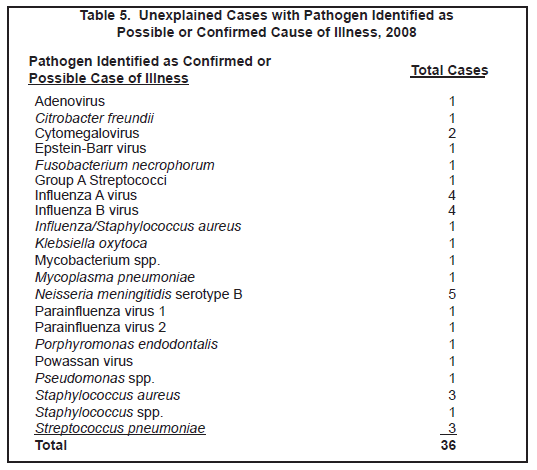Annual Summary of Disease Activity:
Disease Control Newsletter (DCN)
Related Topics
Contact Info
Unexplained Critical Illnesses and Deaths of Possible Infectious Etiology, 2008
UNEX
Surveillance for unexplained critical illnesses and deaths of possible infectious etiology (UNEX) began in September 1995. Any case should be reported, regardless of the patient’s age or underlying medical conditions. A subset of cases (persons up to 49 years of age with no underlying medical conditions, who died of an apparent non-nosocomial infectious process) are eligible for testing performed at CDC as part of a special project. For cases not eligible for the CDC project, some testing may be available at MDH or CDC, at the physician’s request.
Eighty-eight cases (54 deaths and 34 critical illnesses) were initially reported in 2008, compared to 64 cases in 2007. The cause(s) of illness subsequently were determined for 13 cases by the reporting physician and were no longer considered unexplained. Twenty-six cases met the CDC testing criteria as well. Among the remaining 75 cases, 25 presented with neurologic symptoms; 17 case-patients presented with respiratory symptoms; eight presented with cardiac symptoms; seven presented with unexplained sudden death; six presented with shock/sepsis; five presented with sudden unexpected death (SUD); three presented with gastrointestinal (GI) symptoms; one presented with a hepatic syndrome; and eight had an illness that did not fit a defined syndrome (case-patients may present with more than one syndrome). The age of cases ranged from 2 days to 86 years, with a median of 17 years. Forty-six percent resided in the metropolitan area. Fifty-eight percent were male.
The UNEX program works closely with the Minnesota medical examiner offices on unexplained deaths of possible infectious etiology. MDH investigated 13 cases from the Minnesota Regional Medical Examiner Office (MRMEO) in Hastings, 4 cases from Midwest Forensic Pathology, 17 from the Hennepin County Medical Examiner Office, and 2 from the Ramsey County Medical Examiner Office.
There were 36 cases that had pathogens identified as confirmed (n=27) or possible (n=9) causes of their illness (Table 5). The most frequently identified pathogens are of public health significance and include 8 cases of influenza, 5 N. meningitidis, 4 S. aureus, and 3 S. pneumoniae. There were also several unique cases that had public health significance due to being caused by more uncommon pathogens identified in previously healthy individuals. One case was in a 10 year-old male with onset of acute neurologic illness following a tick bite. Serologic and PCR testing revealed an infection with Powassan virus which had not been detected in Minnesota before and is the western-most case ever identified in the United States. Cytomegalovirus was identified in 6 month-old infant who died, through viral culture from the lung and immunohistochemistry staining of the heart. Fusobacterium spp. was found by PCR from a lung tissue sample of a 49 year-old who died at home and had bilateral pneumonia on autopsy. Finally, 16S broad range bacterial RNA testing found Porphyromonas endodontalis from a 55 year-old who died suddenly and had a diagnosis of severe tooth infection with cellulitis and sepsis.
Medical Examiner Surveillance
MED-X is a population-based surveillance program aimed at identifying all infectious disease-related deaths that are investigated by medical examiners (MEs). MDH distributes specimen collection kits to the ME offices and materials to help guide the number and type of specimens collected. Through a combination of active and passive surveillance, ME offices are welcome to partner with MDH to track and identify infectious related deaths. While all ME offices are encouraged to participate, MDH in particular works closely with MRMEO, the Hennepin County Medical Examiner Office, Midwest Forensic Pathology, and the Ramsey County Medical Examiner Office.
There were 124 MED-X cases in 2008; 31 of these were also UNEX cases. Based on MRMEO data, the population-based rate of potential infectious disease related deaths as reported to MEs was 5,252 per 100,000 ME cases, which translates to 2,585 per 100,000 total deaths and 9.8 per 100,000 among the total population. The median age of the cases was 61 years, and 54% were female. There were 58 (48%) cases found through death investigation report review, the majority of which were cases that did not have autopsies (n=49 [84%]). MEs reported 45 (36%) cases. The most common presenting symptom was pneumonia/upper respiratory infection (n=57 [46%]). Among cases autopsied, the most common pathologic finding was also pneumonia (n=32, [56%]), with myocarditis being the second most common (n=28, [49%]). Of the 124 cases, 45 (36%) were confirmed to be due to an infectious cause, 67 (54%) were possibly due to infectious cause, and 12 (10%) were determined to not be due to an infectious cause. Pathogens that were identified as the confirmed or possible cause of death included Streptococcus pneumoniae (n=4), influenza A (n=4), hepatitis C (n=3), Staphylococcus aureus (n=2), Clostridium difficile (n=2), Haemophilus influenzae (n=2), and 1 each of influenza B, parainfluenza, adenovirus, Citrobacter freundii, hepatitis B, Porphyromonas endodontalis, cytomegalovirus, Klebsiella pneumoniae, and Klebsiella oxytoca.

- For up to date information see>> Unexplained Deaths and Critical Illnesses
- Full issue>> Annual Summary of Communicable Diseases Reported to the Minnesota Department of Health, 2008